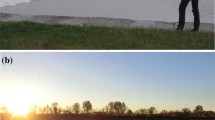Abstract
“TIDAL VORTEX” is a term for a kind of starting vortex formed as a pair of vortices at the head of a tidal jet emanating from a narrow entrance into a bay. In this study, its formation and movement have been investigated by means of a hydraulic experiment and an analytical model. A tidal vortex is formed as a result of flow separation at the abrupt widening of a channel entrance followed by rolling up of the discontinuity surface around its free end. The vortex shows three types of life-history (type I, II and III), which are characterized by the Strouhal number and the aspect ratio of the horizontal shape of the entrance channel. In the case of type-I, the tidal vortex proceeds toward the inner region of the bay and there amalgamates with successive vortex cores into a core of tidal residual circulation. In the case of type-II, the tidal vortex core flows out into the entrance channel on the ebb but returns back into the bay on the subsequent flood. And, in the case of type-III, the tidal vortex core which was formed on the bay-side opening of the entrance channel flows out to the open sea and never comes back, whereas the core which was formed on the open-sea side of the entrance flows into the bay and never flows out. The circulation of a tidal vortex core is proportional to the reciprocal of the Strouhal number. The movement of the core near the bay entrance is determined by interaction between the cores and transportation due to the irrotational component of the tidal current. There are three types of tidal residual circulation, corresponding to three life-history types of tidal vortices. In the case of type-I, a strong tidal residual circulation is formed, but in type-II a small and weak circulation is formed. While, in type-III, the circulation having an inverse sense of rotation to that of type-I is formed.
Similar content being viewed by others
References
Anton, L. (1939): Ausbildung eines Wirbels an der Kante einer Platte. Ing-Arch.,10, 411–427.
Fujiwara, S. (1923): On the growth and decay of vortical systems. Quart. J. Roy. Met. Soc.,49: 75–104.
Hall, M. G. (1961): A theory for the core of a leading-edge vortex. J. Fluid Mech.,11, 209–228.
Kaden, H. (1931): Aufwicklung einer unstabilen Unstetigkeits flache. Ing-Arch.,2, 140–168.
Kashiwai, M. (1984): The concepts of tidal exchange and the tidal exchange ratio. J. Oceanogr. Soc. Japan,40, 135–147. (in Japanese)
Mangler, K. W. and J. H. B. Smith (1959): A theory of the flow past a slender delta wing with leading edge separation. Proc. Roy. Soc.A, 251, 200–217.
Oonishi, Y. (1977): A numerical study on the tidal residual flow. J. Oceanogr. Soc. Japan,33: 207–218.
Pierce, D. (1961): Photographic evidence on the formation and growth of vorticity behind plates accelerated from rest in still air. J. Fluid Mech.,11, 460–464.
Yanagi, T. (1978): Fundamental study on the tidal residual circulation-II. J. Oceanogr. Soc Japan,34, 67–72.
Author information
Authors and Affiliations
Rights and permissions
About this article
Cite this article
Kashiwai, M. Tidal residual circulation produced by a tidal vortex. Journal of the Oceanographical Society of Japan 40, 279–294 (1984). https://doi.org/10.1007/BF02302521
Received:
Revised:
Accepted:
Issue Date:
DOI: https://doi.org/10.1007/BF02302521




